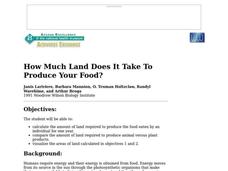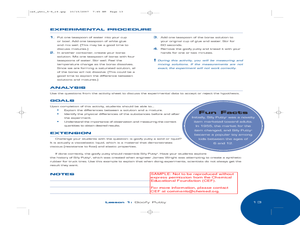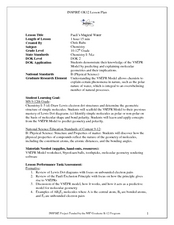Curated OER
Extraction of DNA from White Onion
Students conduct lab test with minced onion to determine where chromosonal DNA is located within the cell, and whether or not it can be extracted.
Curated OER
Extraction of Allicin: The Active Ingredient in Garlic
Learners conduct research to determine the structural formula for Allicin, a component of garlic. They participate in a lab to extract Allicin from garlic and complete a set of questions about their work.
Curated OER
Related to Natural Products
High schoolers examine how the microwave delivers energy at different power levels. They work together to complete experiments on various materials and different power levels. They answer discussion questions to end the lesson.
Curated OER
Developing a Theory About the Nature of the Contents of a Sealed Box
High schoolers observe the changes of a closed chemical system. They record and analyze the data as they manipulate the system. They answer questions to end the lesson.
Curated OER
Entrepreneur: Anita Roddick
Students discover how entrepreneurs make their living. As a class, they identify the characteristics of entrepreneurships and their attitudes. Using the internet, they research the life of Anita Roddick, who founded the Body Shop. They...
Curated OER
How Much Land Does It Take To Produce Your Food?
Students calculate the amount of land required to produce the food eaten by an individual for one year and compare the amount of land required to produce animal versus plant products. They use calorie counting resources to compile the...
Curated OER
Demonstrate Your Chemistry
Students research and evaluate chemical reaction demonstrations that are found on the web. they work in small groups to choose a demonstration that fits a particular category of reaction and then perform the demonstration for the class.
Curated OER
Save The Forest
Students summarize their role as a (particular) specialist. They select items needed for their research in the rainforest. Students explain the problems that their team is faced with and describe how the two assignments relate to botany.
Curated OER
Organization of the Elements and Periodic Table
Students identify how to relate the position of an element in the periodic table to its atomic number and atomic mass. They also identify and interpret how to use the periodic table to identify metals, semimetals, nonmetals, and...
Curated OER
Orfeo: Sinfonie e Ritornelli
Students identify the dramatic expression made by performance and how it relates to the content of the story L'Orfeo. They determine the form of orchestra and each instrumental group within the orchestra for this piece.
Curated OER
Naming Inorganic Compounds
In this compounds activity, students review how to name inorganic compounds and then complete 2 graphic organizers naming the cations and anions.
Curated OER
Goofy Putty
Learners examine mixtures and solution properties by making a borax polymer. In this chemical reactions lesson, students make a putty out of borax solution mixed to create a polymer.
Curated OER
Breaking News English: Tap Water as Good as Bottled Water
In this English worksheet, students read "Tap Water as Good as Bottled Water," and then respond to 47 fill in the blank, 7 short answer, 20 matching, and 8 true or false questions about the selection.
Curated OER
Don’t be a Stoic about Stoichiometry
Students review balancing chemical equations. In this chemistry lesson, students calculate moles of an unknown substance based on stoichiometric relationships in the balanced equation. They cite applications of stoichiometry in the real...
Curated OER
Pauli's Magical Water
Students predict the shape of molecules using VSEPR theory. In this chemistry lesson, students differentiate a polar and nonpolar molecule. They discuss why water's polarity is very important.
Curated OER
Science with Mud!
Eighth graders give some examples of chemical reactions they see everyday. In this chemistry lesson, 8th graders investigate how much water soil can hold. They collect data and compare results with others.
Curated OER
A Solution for Moles
Students calculate the concentration of different solutions. In this chemistry lesson, students explain what a solution is. They explain ways to change the concentration of a solution.
Science Buddies
Science Buddies: Career Profile: Chemist
Discover the role of a chemist, what types of jobs they may seek, the education needed, and other requirements various companies may have for hiring a chemist. This Science Buddies site lays out the requirements needed to become a...
US Department of Labor
Bureau of Labor Statistics: Chemists
The Bureau of Labor Statistics offers a very in-depth resource with a great deal of information about being a chemist.
US Department of Labor
Bureau of Labor Statistics: Chemist
The BLS offers an overview of the career of a chemist. The website provides a general description of what being a chemist is like and includes information on the type of education and experience a chemist needs.
Science Struck
Science Struck: Famous Chemists and Their Contributions
A long list of famous chemists with biographical information and descriptions of their accomplishments.
Thinkport Education
Thinkport: Designing a Healthier, Happier Meal: Stem Career: Food Chemist
Learn about chemists who specialize in food chemistry- the study of chemical processes and interactions in our foods.
The Franklin Institute
Franklin Institute: Welcome to My World!: Medicinal Chemist
Learn what is involved in being a chemist who works to develop new medicinal drugs.
Ducksters
Ducksters: Chemistry for Kids: Famous Chemists
Get some information about some famous chemists who made impacts on their fields! These scientists helped to develop the laws of chemistry and discovered many of the elements.
























